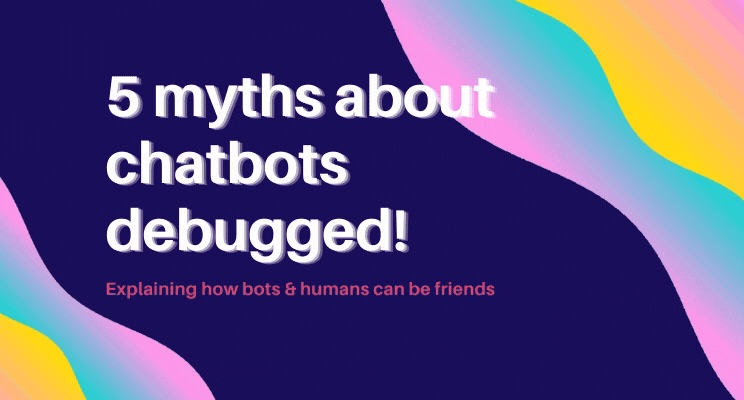5 myths about chatbots debugged!
5 minutes read
Bots are everywhere, yet people are still getting used to the terms ‘chatbot’ and ‘Artificial Intelligence’ (AI).
As of now, these are the main types of chatbots in the market:
- Script-driven bots: Similar to a movie script, these work by following a map of interactions between bot-user interactions, following an A to B conversational journey for the customer that will vary between each use-case.
- Generational-text bots: These use statistical models to imitate human communication, generating text and dialogue patterns.
- Hybrids: Mixing Natural Language Processing (NLP) when identifying categories from users’ messages and directing the user to the relevant dialogue flow.
They can be either text or voice messages, therefore the complexity of data analysis will vary. - Voice assistant is a digital assistant that uses voice recognition, speech synthesis, and NLP to provide a service through a particular application — according to smartsheet.com.

So here are 5 common myths about chatbots to show how bots can be our friends:
1. Chatbots will increase unemployment rates
- Technology can cause mass unemployment, but it doesn’t have to.
- Chatbots are not designed to replace humans, but to support on completing tasks while humans can redirect their time and energy into other complex or more relevant tasks.
- As chatbots are still a ‘foreigner’ software to many, the codependency between bots and humans will continue for many years to come.
- AI will not unemploy humans, but it will transform the foundations of employment as we know it.
2. Chatbots can’t transfer you to live agents
- The right, perfect chatbot should always be able to transfer customers to live agents.
- Critical tasks should be taken over by humans, that’s why a seamless handover platform between bots and agents will both simplify and scale-up businesses.
3. You need to be a programmer to create a chatbot
- With technology evolving so fast, it is possible to create a bot in a few minutes.
- There are code-free platforms that allow you to build chatbots without needing to be a programmer or Deep Learning expert.
4. An FAQ section will do the same for my business as a bot
- An FAQ section in your website is built from general queries that customers have presented over time, but a bot is something else. Besides, bots still provide an instant answer and are available to clear any other doubts users may have over the course of time spent on your website.
- They also allow you to further guarantee a purchase or happy customer, as they secure your users with 24/7 availability from your brand.
5. Customers don’t prefer to talk to chatbots
- 63% of customers are more likely to make a purchase or return to a website if it has an instant chat platform, a survey by Ubisend shows.
- 55% of users prefer to get an instant response for any daily, simple questions — shows the 2018 State of Chatbots Report.
- 40% of millennials rather speak to a chatbot, according to Acquire.
- 35% of consumers hope to see an increase in chatbots’ presence.
Finally, understanding how to cross the bridge between basic bot assistants and fully-scaled conversational AI platforms is key to escalate the current business values.
Still not sure? There’s plenty of resources on the Internet to give you further information about what chatbots really are, and how much truth is behind the fear of robots taking over the world.
You can check Fluido.ai and book a demo with us, where we can take you step-by-step through a hassle and code-free world of conversational AI bots and live agent platform.